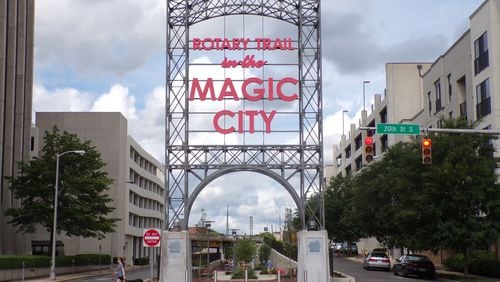Story by Thomas Bell
Like Atlanta, Birmingham grew up at the confluence of railroads, not rivers. Natural features supercharged Birmingham’s growth: rich deposits of iron ore, coal and limestone, the three raw materials needed to manufacture steel. And so Birmingham was built of iron and steel, an origin commemorated by the giant statue of Vulcan that overlooks the city and the rest of Jones Valley from atop Red Mountain, representing the city as does the Atlanta phoenix.
It takes an easy two-hours-and-change drive from Atlanta to visit Birmingham, and even on a short visit, you can discover much of the city’s mighty bones and strong spirit. (My guide was New York Times bestselling author Patti Callahan, who began her writing career in Atlanta and in 2011 moved to Mountain Brook, a municipal suburb that’s like the Decatur to Birmingham’s Atlanta.)
To experience the railroad that made both Southern cities, Amtrak’s Crescent train makes daily runs for about $40 each way, and you’ll be able to sit back and enjoy the scenery.
Both the Amtrak and Greyhound stations in Birmingham are directly adjacent to the recently renovated Railroad Park (railroadpark.org), a 19-acre green space in the heart of downtown Birmingham. The park's regular and seasonal events include a "Symphony in the Summer" outdoor concert series. The Boxcar Cafe overlooks the park's lake.
The park is walking distance from several other Birmingham attractions, including the Alabama Jazz Hall of Fame. Consider the newly opened Rotary Trail, a rails-to-trails conversion with ambitions similar to the Atlanta BeltLine. The Rotary Trail is only partially completed but will eventually connect up with a planned 750-mile network of trails called the Red Rock Trail System (which has 100 miles already finished).
The Rotary Trail begins at Railroad Park's east end, along the Rail Trail, and will take you most of the way to the Sloss Furnaces National Historic Landmark (slossfurnaces.com). The site of Birmingham's first blast furnace for the production of pig iron is awe-inspiring. You walk through the restored facility dwarfed by industrial machinery that once melted and refined iron. Bring your camera or free up memory on your smartphone to capture the site's dramatic construction.
For a fancy night downtown, make your way back west to the Redmont Hotel (redmontbirmingham.com), which opened in 1925 and is the city's oldest operating hotel. A major renovation of the historic downtown building was completed in 2016. The hotel's Harvest Restaurant and Bar serves a seasonally updated menu of simple fare, finely prepared. Then head up to the gorgeous rooftop bar for a nightcap.
Birmingham shares with Atlanta a complicated history with race and civil rights. As revealed in the Birmingham Civil Rights Institute (bcri.org), the city was the battleground for some of the key struggles of the Civil Rights Era. It was home to the brutal segregationist "Bull" Connor and it earned the nickname "Bombingham" for the explosions that terrorized anyone working toward desegregation. The worst of these infamously killed four young African-American girls at the 16th Street Baptist Church in 1963. And it was in a Birmingham jail that Dr. Martin Luther King Jr. wrote one of his most famous published letters.
A museum and center dedicated to promoting civil and human rights, the Birmingham Civil Rights Institute occupies one corner of an intersection that also includes the 16th Street Baptist Church and Kelly Ingram Park. The park was once a gathering place for the Southern Christian Leadership Conference’s nonviolent protest activities and now features several powerful sculptures that commemorate the Civil Rights struggle, including one of the four young bombing victims of 1963.
Drive southeast up out of the valley to Vulcan Park (visitvulcan.com) atop Red Mountain and take the elevator or stairs up to the observation deck at the feet of a giant statue of Vulcan, the largest cast-iron statue in the world, according to the park. The deck also offers an inspiring view of Jones Valley.
From Vulcan Park, consider a detour to the Little Professor Book Center, a favorite independent bookstore, then head east to the Birmingham Botanical Gardens, which is always free and feature English rose gardens, fern gardens, Asian gardens and more.
Finish your day in style at the serene but luxurious Grand Bohemian Hotel in nearby Mountain Brook. Dine at the hotel's Habitat Feed and Social restaurant for high-end, updated classics with an extensive seafood menu, or enjoy the hotel's beautiful rooftop terrace bar.
Some of Patti Callahan’s other favorite places include the Birmingham Zoo, the Birmingham Museum of Art, Woodland Cycle Café, the Birmingham Public Library and Desert Island Supply Company (DISCO), a nonprofit creative writing program that gives a voice to underserved children in Birmingham.
When you’ve fit all you can into one visit, head on back to Atlanta, knowing that both cities are connected by much more than rail lines and have been through many transformative fires.
Insider Tip
This year’s Sloss Music and Arts Festival will be held June 14-15, with headliners including Chris Stapleton and Arcade Fire. slossfest.com
Thomas Bell has written about the arts for 20-plus years for such publications as Creative Loafing and The Atlanta Journal-Constitution.






